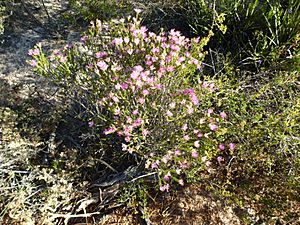Melaleuca bisulcata facts for kids
Quick facts for kids Melaleuca bisulcata |
|
|---|---|
 |
|
| M. bisulcata in Kalbarri National Park | |
| Scientific classification | |
| Genus: |
Melaleuca
|
| Species: |
bisulcata
|
Melaleuca bisulcata is a unique plant found only in a small part of Western Australia. It's a type of Melaleuca, which are often called "paperbarks" or "honey myrtles." This plant is a bit tricky to tell apart from another similar plant, Melaleuca psammophila. The main difference is in the shape of their calyx lobes, which are parts of the flower.
Contents
What Does Melaleuca bisulcata Look Like?
Melaleuca bisulcata is a shrub that can grow up to about 1.3 meters (4.3 feet) tall. Its leaves are packed closely together. Each leaf is about 4.8 to 7.2 millimeters (0.19 to 0.28 inches) long. They are also quite narrow, measuring about 0.9 to 1.7 millimeters (0.035 to 0.067 inches) wide.
The flowers of this plant grow in small groups at the ends of its branches. After the flowers bloom, the branch keeps growing. Each flower head has 1 to 4 groups of flowers, usually in pairs or threes. The flowers have pink, purple, or magenta-colored parts called stamens. These stamens are arranged in five bundles around each flower. There are usually 6 to 12 stamens in each bundle.
Melaleuca bisulcata flowers during September and October. After the flowers, the plant produces woody capsules. These capsules are like small, hard seed pods. They are about 4.8 to 6.5 millimeters (0.19 to 0.26 inches) long.
How Did It Get Its Name?
The plant Melaleuca bisulcata was first officially described in 1862. This was done by a famous botanist named Ferdinand von Mueller. He found a sample of the plant near the Murchison River. This sample was collected by Augustus Oldfield.
The second part of its scientific name, bisulcata, comes from Latin words. "Bi-" means "two," and "sulcatus" means "furrowed" or "grooved." This name refers to the dried leaves of the plant. They often have two long grooves running along them.
Where Does It Grow?
This special melaleuca plant is found in the Kalbarri district of Western Australia. It grows in areas known as the Geraldton Sandplains and Yalgoo biogeographic regions. These are specific natural areas with similar plants and animals.
You can find Melaleuca bisulcata growing in different types of soil. It likes sand, sandy clay, and gravel. It often grows over a type of rock called laterite. You might spot it on sandplains or along the sides of roads in these areas.
Is It Endangered?
Good news! The Melaleuca bisulcata is currently not considered to be in danger. The Government of Western Australia's Department of Parks and Wildlife lists it as "not threatened." This means there are enough of these plants in the wild for now.
Images for kids



